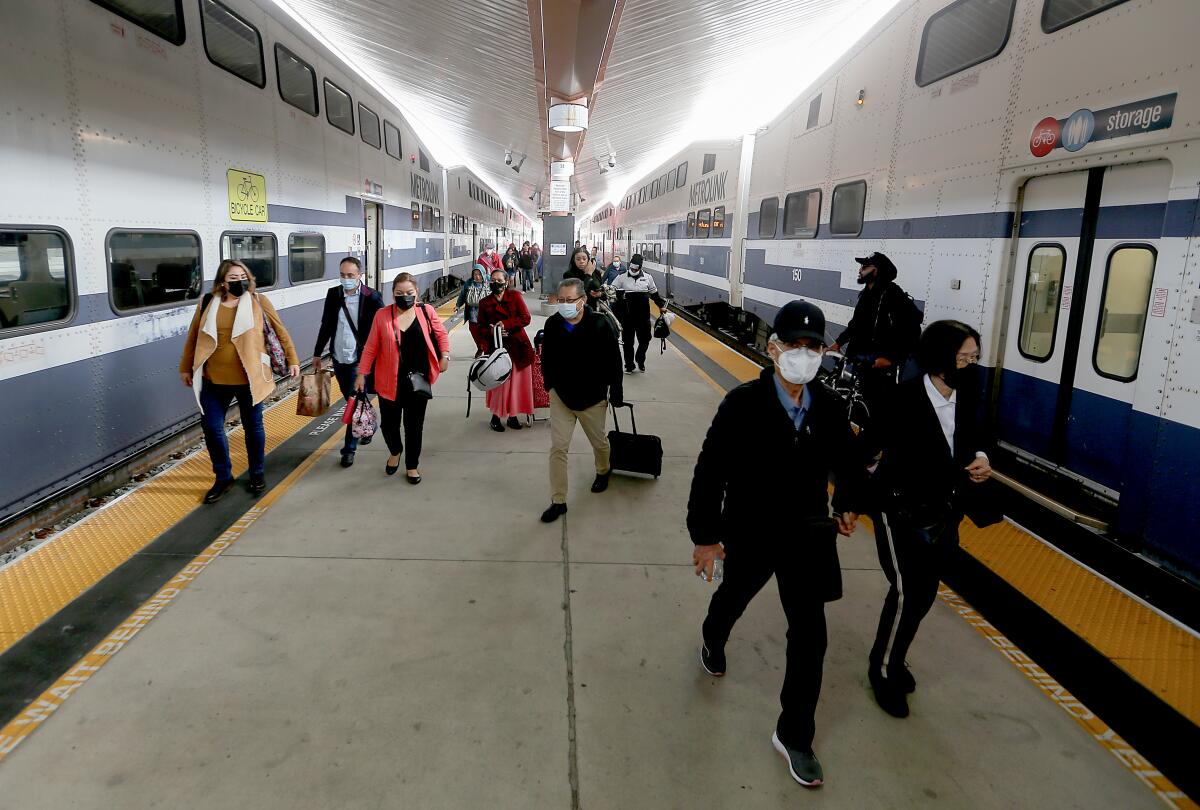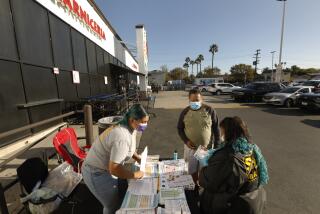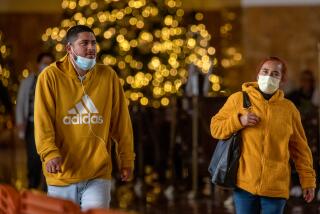L.A. County coronavirus cases, hospitalizations rising again, dashing hopes surge has crested

Coronavirus cases and hospitalizations are increasing in Los Angeles County, dashing hopes that the nation’s most populous county had turned the corner in the latest Omicron wave.
What appeared to be a possible flattening or decrease in cases may have just been a result of a lag in case reporting over the Memorial Day holiday, and it’s possible that transmission increased from gatherings over that weekend.
“The earlier decrease was likely related to lower testing over the Memorial Day holiday, while the subsequent increase may be related to increased spread associated with travel and gatherings during the long holiday weekend and as we head into summer,” L.A. County Public Health Director Barbara Ferrer said Thursday.
L.A. County is averaging about 5,100 coronavirus cases a day for the weekly period that ended Friday; that’s up 20% from the prior week. On a per capita basis, L.A. County is recording 350 new coronavirus cases a week for every 100,000 residents; a rate of 100 or more is considered a high rate of transmission.
There were 6.4 new coronavirus-positive hospitalizations per week for every 100,000 residents, which is up 21% over the previous week. The current figure places L.A. County in the medium COVID-19 community level as defined by the Centers for Disease Control and Prevention; once the rate of new weekly hospitalizations hits 10 or more, a county is reclassified as being in a high COVID-19 community level.
The CDC recommends that everyone age 2 and up in counties with a high COVID-19 community level wear a mask in indoor public settings. L.A. County plans to go a step further should it reach the high COVID-19 community level and reinstitute a universal indoor mask mandate in public settings for those age 2 and up.
Based on existing trends, L.A. County is on track to move by early July into the high COVID-19 community level, and as a result, could see a new universal mask order for indoor settings by early July.
“This is a little later than we had projected last week. And the changes [in the projection are] because the rate of increase in hospital admissions slowed slightly these past two weeks,” Ferrer said.
The actual result could change — hospitalizations could accelerate if more people get infected, but it’s also possible that L.A. County could avoid hitting that threshold and not need a new mask mandate again if residents take steps to avoid getting infected or spreading disease.
Ferrer has for months outlined how a move into the CDC’s high COVID-19 community level — which assesses communities based on case and hospitalization rates — would trigger another universal mask order for indoor public settings for L.A. County.
“We’ve got to get comfortable with the idea that, when our numbers don’t look great, it’s really sensible to layer in some of the additional protections [such as masking] while we try to understand what might be going on with these emerging sublineages of Omicron,” Ferrer said.
A reinstatement of a mask mandate in L.A. County would echo the position of Alameda County, the San Francisco Bay Area’s second-most populous county, which imposed such a requirement last week. But it would be at odds with other Bay Area counties, including San Francisco and Santa Clara counties, that say they don’t plan to impose such a mask order for now.
When asked about the reasons for the diverging decisions, Ferrer said that “L.A. County looks more like Alameda than it does San Francisco County and share, I think, a similar perspective on the ease of which we can go ahead and add in a very important and powerful safety measure with masking and the impact that can have particularly on the disproportionate effects of high transmission in some communities when compared to others.”
Compared with highly populated counties in the Bay Area and in coastal Southern California, L.A. County has a considerable number of large, densely populated areas where many low-income people live in overcrowded housing, which puts them at greater risk for severe COVID-19.
Compared with San Diego, Orange and Ventura counties in Southern California, L.A. County has the lowest median household income — about $71,000, according to Census Reporter. By contrast, the figure is about $82,000 in San Diego County, $89,000 in Ventura County and $94,000 in Orange County.
Among the Bay Area’s five most populated counties, Alameda County and its East Bay neighbor, Contra Costa County, have the lowest median household income, $104,000 to $105,000. By contrast, it’s $119,000 in San Francisco, $128,000 in San Mateo County and $131,000 in Santa Clara County.
Also worth noting, Ferrer said, is that “we continue to see higher rates of hospitalizations and higher rates of death among communities of color and among people who live in communities that have higher rates of poverty.”
L.A. County has a greater proportion of Latino and Black residents; 48% of residents are Latino, and 8% are Black. In San Francisco, 15% of residents are Latino and 5% are Black.
Black and Latino residents have been especially hit hard in the pandemic.
The outlook for the coming weeks is still difficult to forecast.
On the bright side, sewage treatment plants in L.A. County are not reporting a substantial increase in coronavirus levels in wastewater over the previous week. “But I’m not sure that means we’ve turned the corner,” Ferrer said.
In fact, there are some new concerning signs on the horizon, as even newer Omicron variants take root. BA.4 and BA.5, which caused significant growth in viral transmission in South Africa, are increasingly being detected in California and nationwide.
One question that hasn’t been answered is whether the refreshed version of the COVID-19 vaccines being tested by Pfizer and Moderna, which could be distributed for use later in the year, “are going to hold up against BA.4 and BA.5,” said Dr. Ashish Jha, the White House COVID-19 response coordinator, at a UC San Francisco panel discussion last week. “They’re going to have some data on that in the next couple of weeks.”
“We have the possibility now of starting to see more BA.4 and BA.5. Will they crowd out BA.2.12.1?” Ferrer said, referring to a highly contagious subvariant that is among the more dominant subvariants in L.A. County.
“We have no way of knowing, but we’re going to be cautious,” Ferrer said. “It’s too early to determine whether or not we’ve turned the corner. We don’t see a lot of indications of turning the corner at the moment.”
BA.4 and BA.5 are of concern because of their rapid growth detected recently. Nationally, the duo went from comprising 1% of viral specimens analyzed nationally to 13% in just a single month, according to the CDC.
“This suggests that they may have the ability to outcompete other circulating variants. There’s also concern that they may be able to cause reinfections in people who have already been infected by other Omicron subvariants,” Ferrer said.
“Because of this rapidly changing variant landscape, it remains important to use measures that are protective against all the variants, including masking, moving activities outdoors, maximizing your ventilation when you’re indoors, and testing and staying home if you’re sick,” Ferrer said.
L.A. County’s test positivity rate is now 4.7%, about double the figure from one month ago.
The number of coronavirus-positive outbreaks in nursing homes is increasing in L.A. County, with 40 new outbreaks this past week, up from 14 the prior week. Officials consider the outbreaks in nursing homes to be at a level of high concern.
“While hard-working staff can — and they do — take extra measures to prevent transmission at these facilities, if transmission rates are high in the surrounding community, it increases the likelihood that residents and staff will be exposed to infected individuals,” Ferrer said.
Ferrer is also expressing concern at how the coronavirus has again started to spread more thoroughly in disadvantaged neighborhoods, where residents are more vulnerable to COVID-19.
“We’ve seen in past surges that they can sometimes start first in the higher-income areas before moving into lower-income areas, where there are fewer resources and the potential for more exposures at worksites and in the community,” Ferrer said.
In addition, between May 31 and June 6, coronavirus case rates were climbing much faster in poorer areas, rising by 23% in the lowest-income areas of L.A. County, compared with a 10% increase in the highest-income areas.
Another point of concern, Ferrer said, is that there has been a slight increase in emergency room visits related to COVID-19.
There is also an increasing number of clusters of coronavirus cases at worksites. There were 259 reported clusters of coronavirus cases for the weekly period that ended Tuesday; for the prior week, there were 186. A number were in the retail trade sector — especially at food and beverage stores, building material and garden equipment and supply dealers, as well as sites in the manufacturing industry and in the professional scientific and technical services sectors.
COVID-19 deaths remain relatively low and steady in L.A. County, which is reporting about seven deaths a day over the past week.
“Each death, however, is an acute loss which ripples out through families in the community. We know and we understand that those affected are forever changed by this terrible pandemic and our thoughts and prayers remain with those families,” Ferrer said.
More to Read
Sign up for Essential California
The most important California stories and recommendations in your inbox every morning.
You may occasionally receive promotional content from the Los Angeles Times.











